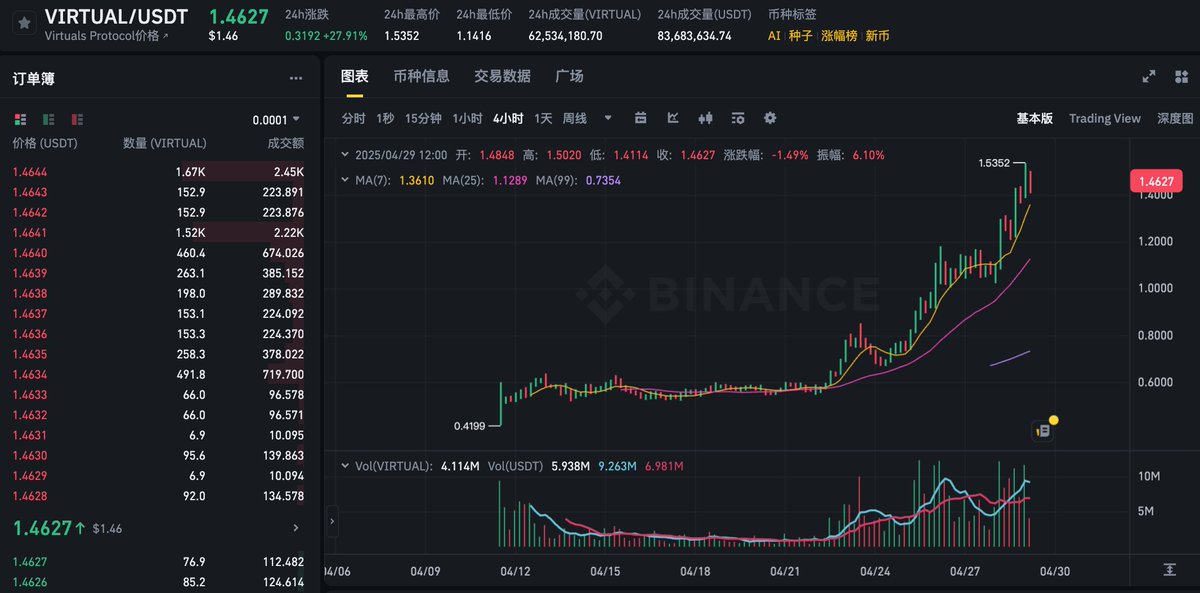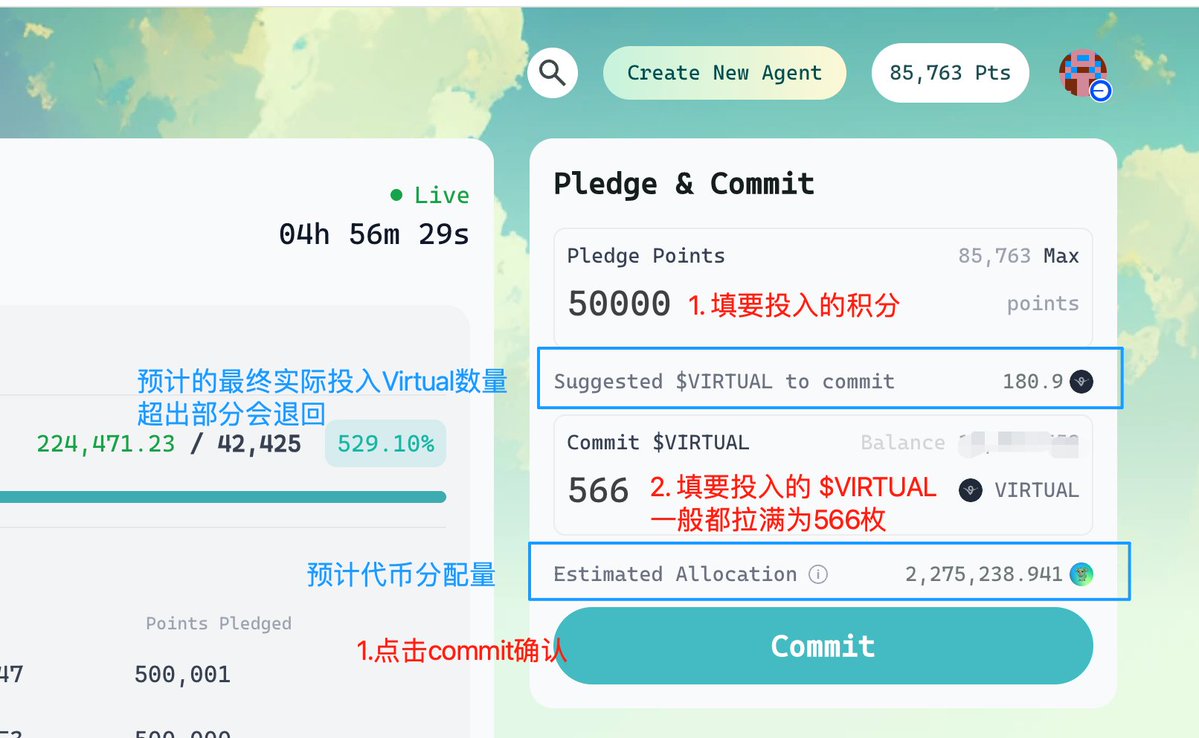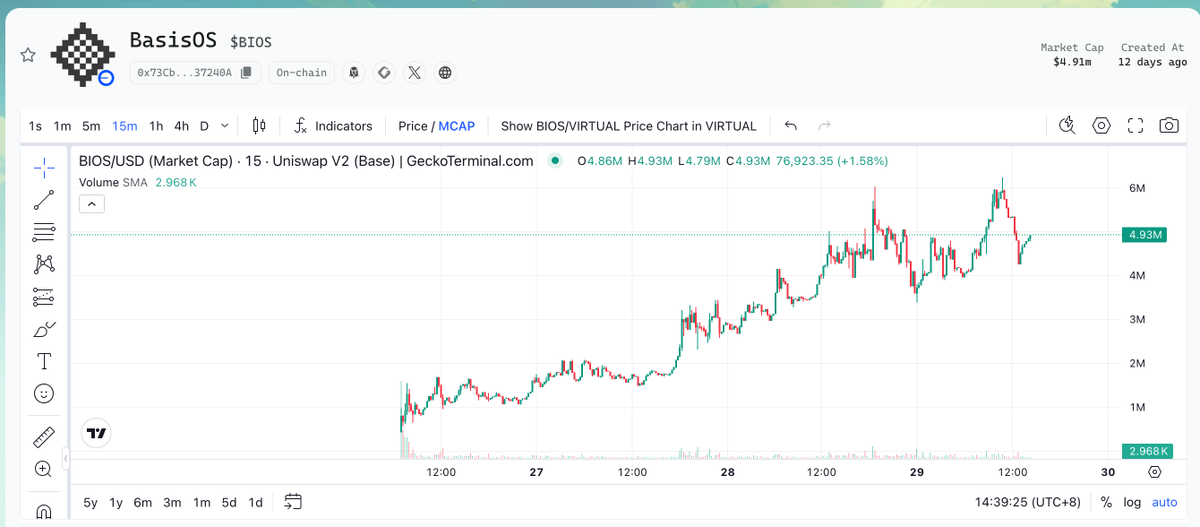《Understanding the Latest Points Minting Machine - Detailed Explanation of @virtuals_io's Geneses Launch Model》
Recently, those who follow me may have noticed that I talk about $VIRTUAL almost daily. Since Virtual was listed on Binance spot trading, its performance has been very stable. Shortly after its spot listing, the Geneses presale model was launched, and the price skyrocketed. I managed to gain some profits both from the presale and the token price.
Currently, Virtual's price has risen steadily from around 0.5u to 1.4u, consistently appearing on Binance's top gainers list.
The Geneses model has introduced several presale projects, with returns ranging from three to five times to dozens of times. After launch, these projects have shown stable performance and high growth potential.
For participating users, there are two significant conclusions:
1. Virtual's Geneses presale model is highly profitable, with good projects yielding high multiples.
2. The proportion of investment depends on the points you hold, so it's essential to find ways to accumulate more points.
Here, I’m writing a post to provide a comprehensive introduction and offer some tips and additional insights for those looking to earn points. I also hope to spark discussions so everyone can share effective strategies for earning points. Let’s aim to master this model and seize significant opportunities.
Links related to the Geneses Launch model are placed in the comments section for bookmarking and easy access later.
Now, let’s dive into the detailed explanation of the points system.
1. Introduction to the Geneses Model
In one sentence: The Virtual Geneses points model determines the investment proportion based on the ratio of points in an oversubscription model.
Traditional oversubscription models allocate based on the proportion of investment amounts, with relatively low entry barriers. Even if there’s a cap per wallet, large investors can use multiple wallets to secure more allocation. Virtual's Geneses model, however, allocates based on points, requiring users to decide the number of points to invest in each project.
The advantage of this model is that it locks allocations for contributors to the ecosystem. Since earning points is not easy, strategies like using multiple wallets for presales are less effective, ensuring sufficient distribution of tokens from the start.
Here’s a table summarizing the differences between traditional presales and Virtual Geneses.
2. How to Participate in Geneses Presales
Once you have points and 566 $Virtual tokens in your wallet, you can invest in projects on the presale website.
To participate, enter the presale interface of an ongoing project. In the top-right corner, select the number of points to invest, input the points and Virtual token amount, and click Commit.
To check your points and overall allocation, click the points amount in the top-right corner to access the points page. Here’s the link.
3. How to Earn Points [Key Section]
The official guidelines don’t detail how many points can be earned. The following are my findings based on personal experience. If anyone has better suggestions, feel free to share them for additional insights.
1. Buying Tokens [Points Valid for 30 Days]
Whether buying $LUNA, $AIXBT, or tokens under the new Geneses model, points are allocated. Here are some observations:
① If you participate in Geneses token presales without selling the presale tokens and additionally purchase tokens, you earn significantly more points.
② Buying new tokens yields more points than buying older tokens.
③ The more Virtual tokens you spend, the more points you earn, with additional point bonuses likely based on a tiered system.
2. Holding $Virtual [Permanent Points]
Storing Virtual tokens in a Base chain wallet earns daily point allocations. Based on my tests with different wallets, the allocation isn’t strictly proportional to the number of Virtual tokens held. There’s likely a tiered system, where holding more tokens results in higher bonuses.
For example, one wallet with over 10,000 Virtual tokens earned 2,000-3,000 points daily, while another wallet with 3,000 Virtual tokens earned only 300-400 points. Hence, it’s recommended to store most of your Virtual tokens in a single wallet to maximize points.
3. Staking VADER [Permanent Points]
Recently, $VADER has been rising in value, as staking VADER also earns significant point allocations.
4. Participating in Yaps to Earn Points [Points Valid for 30 Days]
Participating in Yaps is similar to Kaito campaigns, where you post tweets and fill out forms to earn points. Many people overlook this, but it’s worth doing. Influencers (KOLs) with large followings can leverage their influence to earn free points, contributing to the ecosystem.
Interestingly, even KOLs with only a few hundred or thousand followers have earned tens of thousands of points through Yaps.
Note: Ensure your wallet is linked to the Virtual website and Twitter account; otherwise, points won’t be allocated to your wallet.
Submit Yaps link
Official Yaps tweet
Additional Notes: The above suggestions are based on my practical experience. Since the point allocation rules aren’t explicitly detailed, I believe this lack of transparency is beneficial. Otherwise, users might exploit the rules, leading to diminishing returns. Binance’s recent point system illustrates this, where users rushed to optimize their spending based on the rules, ultimately reducing the rewards.
Hence, the current semi-black-box approach is ideal. We only need to understand the essence of points: they flow to contributors to the ecosystem and diamond-handed holders.
4. Virtual’s Oversight and Issue Resolution for Projects
This section is dedicated to Virtual’s excellent oversight and problem resolution for projects, which I believe should be emulated by all projects.
1. Addressing Point Allocation Issues with $BIOS
After the $BIOS presale, some users experienced insufficient or excessive allocations. Virtual promptly investigated and compensated users. Compensation details include:
① Users with excess allocations can retain the surplus.
② Users who received insufficient allocations but claimed tokens can request the remaining tokens.
③ Users who haven’t claimed tokens can still do so. If tokens are insufficient, Virtual will airdrop three times the value in $VIRTUAL to their wallets.
④ Points for users with insufficient allocations will be fully refunded (essentially free allocation).
Original tweet
Current $BIOS chart
2. Handling Rug Project $PLAY
As Virtual Geneses projects increase, a rug project emerged recently. The presale was oversubscribed five times, but the project team suddenly tweeted asking users to send Virtual tokens to a specific address. Virtual promptly took the following actions:
① Halted the $PLAY presale, marking it as permanently failed.
② Issued a tweet reminding users that participants would receive points and refunds.
③ Compensated users who sent funds to the fraudulent address, provided their wallets had points.
As a result, no users suffered financial losses.
Original tweet
Virtual’s approach to addressing issues is commendable: no evasion, no perfunctory responses, and genuine problem-solving to benefit users.
5. Final Thoughts
VIRTUAL is the project that yielded my best results last year, and I have high expectations for it. Despite market corrections and cooling AI trends this year, VIRTUAL has experienced significant pullbacks. However, its products and the team’s efforts demonstrate a long-term commitment to making the VIRTUAL token successful.
Over the past few months, I’ve frequently seen tweets from prominent figures joining the @virtuals_io team, reflecting their genuine sentiments.
In this relatively volatile market, finding truly valuable projects is rare. Treasure them and proceed with caution!
Show original



241
49.03K
The content on this page is provided by third parties. Unless otherwise stated, OKX TR is not the author of the cited article(s) and does not claim any copyright in the materials. The content is provided for informational purposes only and does not represent the views of OKX TR. It is not intended to be an endorsement of any kind and should not be considered investment advice or a solicitation to buy or sell digital assets. To the extent generative AI is utilized to provide summaries or other information, such AI generated content may be inaccurate or inconsistent. Please read the linked article for more details and information. OKX TR is not responsible for content hosted on third party sites. Digital asset holdings, including stablecoins and NFTs, involve a high degree of risk and can fluctuate greatly. You should carefully consider whether trading or holding digital assets is suitable for you in light of your financial condition.

